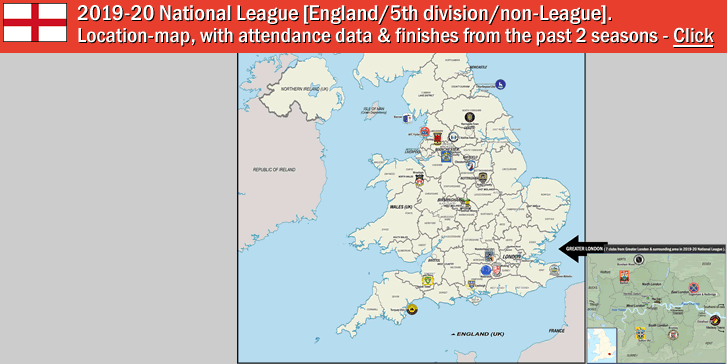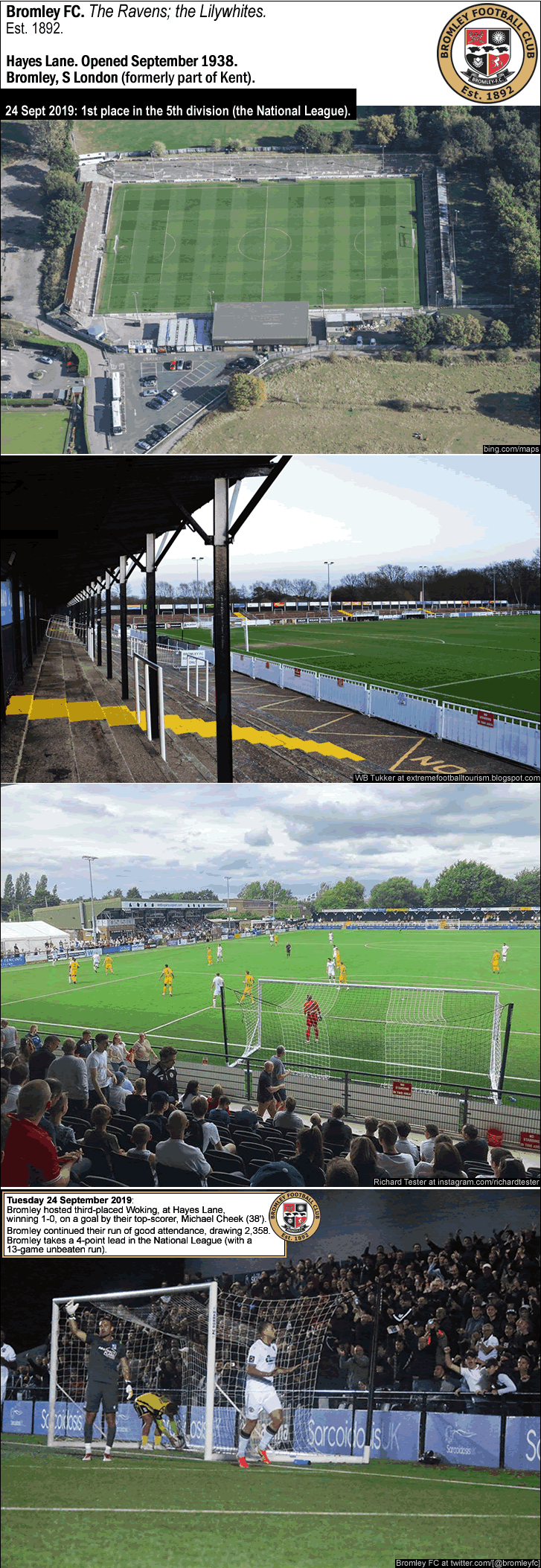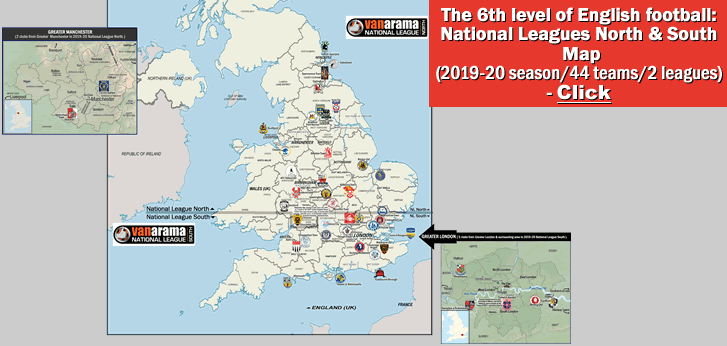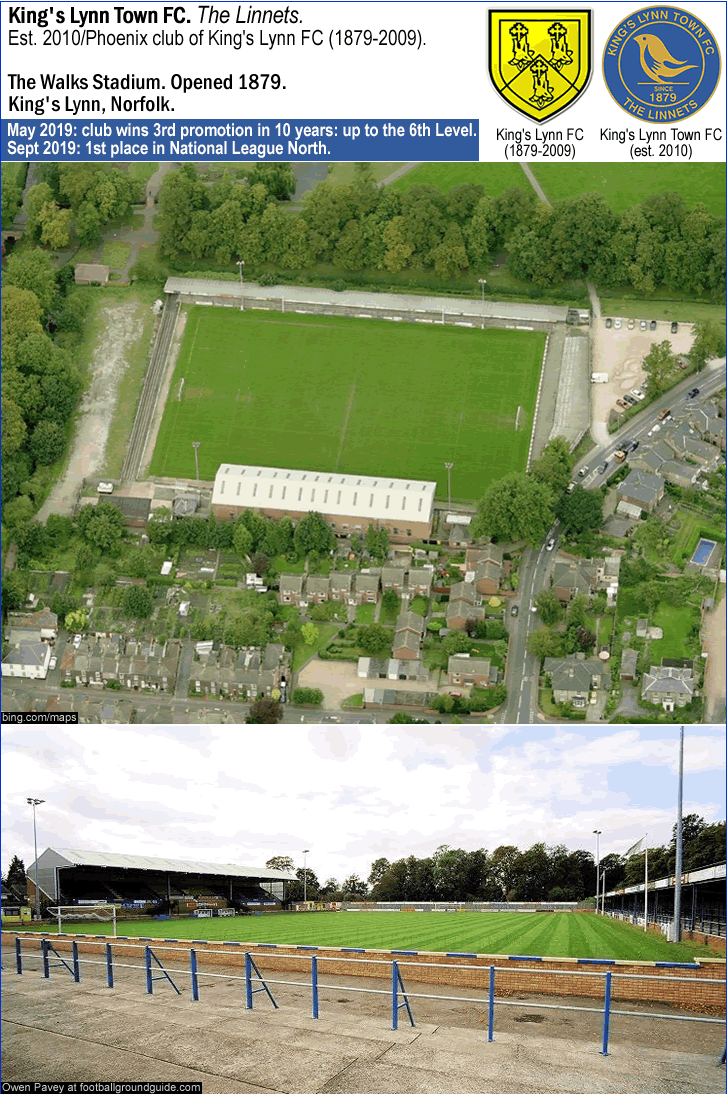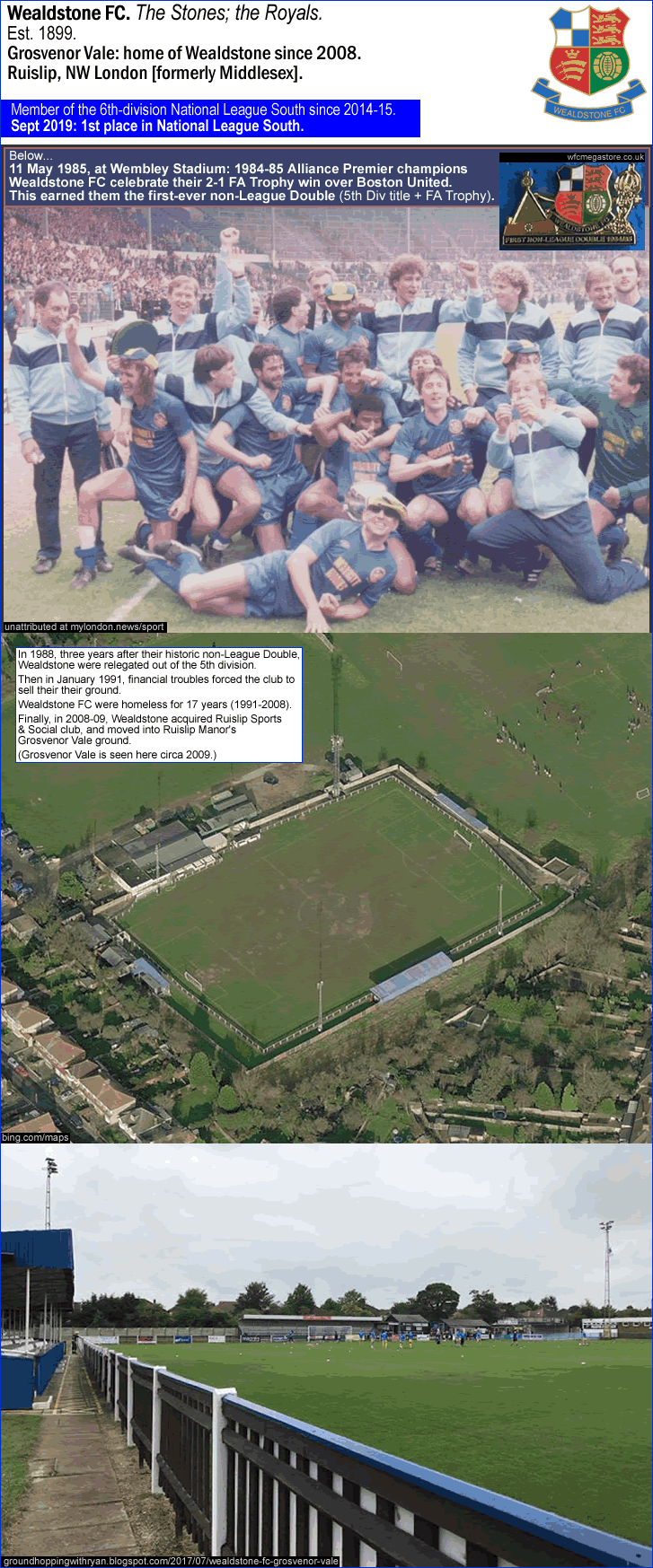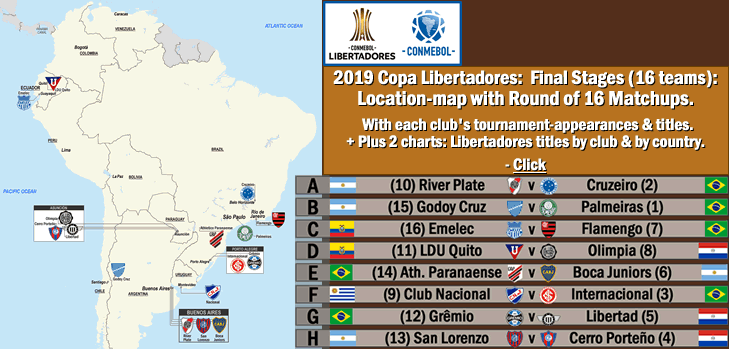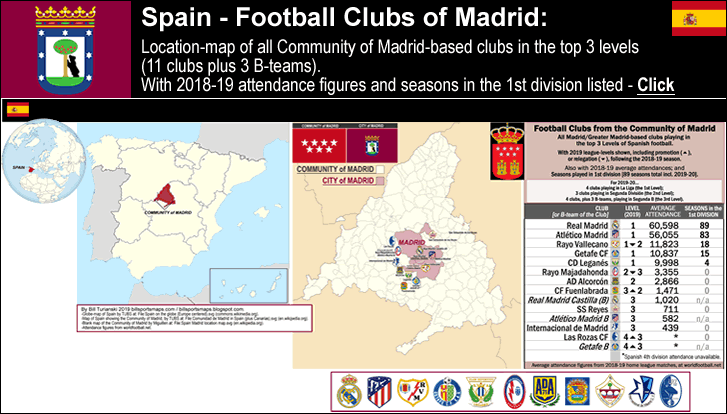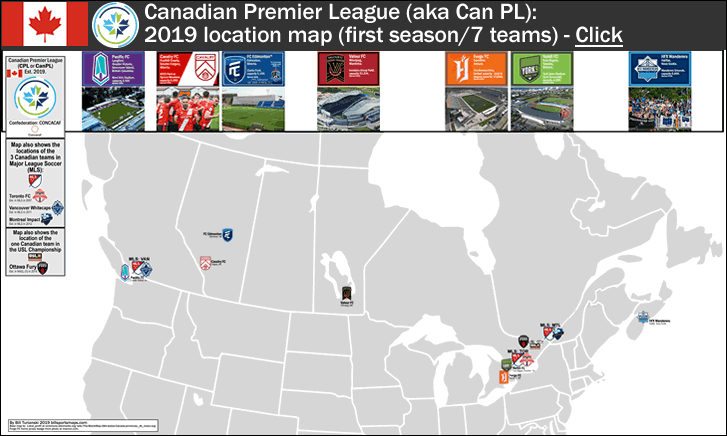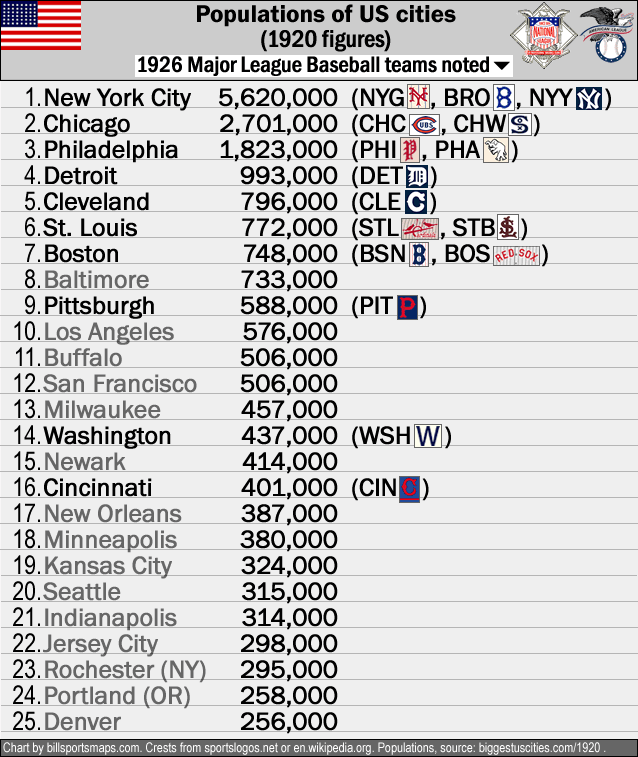
2019-20 FA Cup 1st Round map with current league attendances & fixture list
…
…
By Bill Turianski on 3 November 2019; twitter.com/billsportsmaps.
Links…
-The competition…FA Cup (en.wikipedia.org).
-BBC’s page on the competition…bbc.com/fa-cup.
-Fixtures, results, etc…Summary – 2019-20 FA Cup 1st Round (soccerway.com).
-FA Cup Factfile…blog: facupfactfile.wordpress.com; twitter.cm/[@facupfactfile].
…
Breakdown of the 79 clubs in the 2019-20 FA Cup 1st Round Proper (by Division or Level)…
∙3rd division (EFL League One) – 23 clubs.
∙4th division (EFL League Two) – 24 clubs.
∙5th division (non-League National League) – 15 clubs.
∙6th level – 10 clubs (5 NL-North, 5 NL-South).
∙7th level – 5 clubs (1 Northern Prem, 1 Southern Prem South, 1 Southern Prem Central, 2 Isthmian Prem).
∙8th level – 2 clubs (1 Isthmian North, 1 Isthmian South East).
There are 79 clubs in the 2019-20 FA Cup 1st Round – instead of the usual 80 clubs – due to the demise of Bury FC (ex-3rd division) {see this, from 28 August 2019 at bbc.com/football}. That left a gap in the FA Cup 1st Round. So, it had been decided that during the 1st Round Draw, the last team in the pot would receive a bye to the 2nd Round. That team was West Sussex-based 8th-tier side Chichester City. And Chichester City who are the lowest-placed team still alive in the competition, announced they would donate part of their 36,000 prize to ‘the appropriate organisation involved with the continuation of Bury’. {See this from sport.net via Press Association.} {See this: Chichester City players react to receiving a bye into the second round of the #FACup! (twitter.com/[@NonLeaguePaper]).}
Speaking of Chichester City… I am considering them not to be FA Cup 1st Round first-timers. Because one of the two clubs which merged to form the present day Chichester City (II), in 2000, was Chichester City (I) (1873-2000). And that original Chichester City qualified for the 1960-61 FA Cup 1st Round. And the new Chichester City, which merged with Portfield FC in 2000 to become Chichester City United, retained the league-position AND the records of Chichester City (I). [Chichester City United changed their name back to Chichester City (II) in 2009.] At the present-day Chichester City’s Pichero.com page, in the History section {here in the 14th paragraph there}, it confirms this, by saying, “Following a merger with local rivals Portfield FC in 2000 the club became known as Chichester City United FC, with the previous records of Chichester City FC being retained as the actual club’s history.” Also, see the Chichester City page at Football Club History Database {here}, which says the same thing…that Chichester City (I/1873-2000) and (II/2000-present) are the same club.
Also, some media are considering Darlington FC to be FA Cup 1st Round first-timers, but the re-formed club has been allowed by the football authorities to retain the history of the original Darlington FC. {See this article from TheNonLeaguePaper.com from April 2017; see Darlington FC’s Wikipedia page, which shows records of club back to 1883, here}.
…
- Maldon & Tiptree FC (an 8th level club), who, on the 19th of October 2019 qualified for the FA Cup 1st Round, for the first time ever…
Maldon is a town of 14,000 on the Blackwater Estuary in coastal Essex. Maldon is located, by road, 50 miles (80 km) NE of central London. The most famous thing to come out of Maldon is salt: Maldon Sea Salt (est. 1882), which is harvested from the area {see this article at BonAppetit.com}.
Maldon Town FC were formed in 1946; they were amalgamated in 2010. By 2009-10, Maldon Town were playing in the Isthmian League D1 North (in the 8th level of the English football pyramid). In 2009, the chairman of nearby Tiptree United bought Maldon Town. At that point in time, Tiptree Utd were in the 9th-level Essex Senior League. (Tiptree is a town of 9,000, located, by road, 8 miles (12.5 km) north of Maldon.) In the following season (the 2010-11 season), the two clubs combined as Maldon & Tiptree FC. It was billed as not officially being a merger, as Tiptree Utd retained their license. {See this article at the Maldon Standard site.} But Tiptree Utd never fielded a senior team again…so, yeah, it was a merger, when all was said and done. The new and amalgamated club kept the Royal Blue of Maldon Town, and added Tiptree United’s Red (from Tiptree’s red-with-black colours), to make a kit featuring Royal-Blue-and-Red vertically-striped jerseys. They would play at Maldon Town’s ground (the Wallace Binder Ground, which opened in 1994), but would have a nickname derived from Tiptree United’s moniker of ‘the Jam-makers’. That nickname was a reference to the local jam-making industry of Tiptree, and a variation of it was chosen by supporters in a poll. Thus, the ‘Jammers’ of Maldon & Tiptree were born.
Currently [3 November 2019], Maldon & Tiptree are in an 8th-division promotion race, sitting in 2nd place, 2 points behind Bury Town (with 3 games in hand). {Isthmian D1 North table (soccerway.com).} When they clinched qualification for the 2019-20 FA Cup 1st Round, Maldon & Tiptree were averaging 135 per game. (They drew 65 more than that in their next league home match since then, on 2 November). Currently, Maldon & Tiptree are averaging 146 per game, a figure that is 37-per-game below the median average attendance in their league. So Maldon & Tiptree are a rather small club to have qualified for the FA Cup 1st Round, and are in fact the lowest-drawing club in the 1st Round this year. {Isthmian North attendances here (nonleaguematters.co.uk).}
Since their amalgamation in 2010-11, Maldon & Tiptree have remained in the 8th level, staying ten years now in the same league (which is now called the Isthmian North). In their 9 full seasons of existence, Maldon & Tiptree have made it to the play-offs 3 times. But they have faltered each time in the play-offs final, losing there in 2013 to Thamesmead Town [on penalties]; then losing there in 2017 to Thurrock Town; then losing there last season [2019] to Heybridge Swifts [on penalties]. So you could say there were due for a run of good fortune, and that has now happened.
Maldon Town had never made to the FA Cup 1st Round Proper in 63 years of trying. Tiptree United (est. 1933) had likewise had never qualified for the 1st round of the world’s oldest football tournament. But in the late summer and early autumn of 2019, under manager Wayne Brown, this small Essex-based club made a Cup-run that saw them qualify for the FA Cup 1st Round. {See photos, screenshots and captions below.} From the Maldon & Burnham Standard, from 19 October 2019, by Simon Spurgeon, FA Cup history for Brown’s Maldon & Tiptree side (maldonandburnhamstandard.co.uk/sport).
Maldon & Tiptree got to the First Round this way…Beating Saffron Walden Town (a 9th-level club), away, in the Preliminary Round. Then they beat fellow Isthmian North club Histon, away, in the 1st Qualifying Round. Then they beat 7th-level Isthmian side Wingate & Finchley, at home in front of 149, in the 2nd QR. Then they beat 8th-level Isthmian South Central side Chertsey Town, at home in front of 225, in the 3rd QR. And then Maldon & Tiptree qualified for the FA Cup Proper by beating 8th-level Southern Central side Royston Town, away, by the score of 1-3, in the 4th QR. Goals for Maldon & Tiptree were courtesy of a Royston own-goal early in the first half, followed by a 31st-minute goal from Danny Parish, then a 65th-minute goal from top-scorer Jerome Slew that clinched it. That 3rd goal was the result of some excellent team play {see screenshot and caption below}. {Note, the 3rd goal can be seen at the 7:05 mark of the following video, from Royston Town FC TV, at youtube.com.}
For the FA Cup 1st Round draw, which was actually held at Maldon & Tiptree’s Wallace Binder Ground, Maldon & Tiptree were drawn versus just-promoted 4th-division side Leyton Orient. This is a decent draw for Maldon & Tiptree, as it is a somewhat winnable match, plus their traveling fans will not have a long trip, at all, to reach Orient’s Brisbane Road ground down there in East London.

Photo and Image credits above – Maldon & Tiptree home kit illustration, from en.wikipedia.org/[Maldon & Tiptree F.C.]. Aerial shot of Maldon, Essex, photo by oneblackline at File:Maldon 060309.jpg (commons.wikimedia.org). Maldon’s harbor, photo from visitmaldon.co.uk. Wallace Binder Ground (circa 2015), photo by boycopus at [the now-defunct] panoramio.com via us.soccerway.com/[Maldon & Tiptree FC]. Main Stand at Wallace Binder Ground, photo by local bus driver at flickr.com. Maldon & Tiptree jersey badge [ca. 2019-20], photo from instagram.com/[@beautifulgame15 (here) via instazu.com/profile/beautifulgame15. 3rd goal that clinched Maldon & Tiptree's FA Cup 1st Round qualification (65' goal by Jerome Slew), screenshot from video by Royston Town FC TV at youtube.com. Danny Parish and Jorome Slew, photos from pitchero.com/clubs/maldonandtiptreefc. Maldon & Tiptree Players celebrate with traveling fans, screenshot from video at twitter.com/[@MaldonTiptreeFC]. Manager Wayne Brown, photo from maldonandburnhamstandard.co.uk
___
Thanks to all at the following links…
-Blank map of UK historic counties, by Nilfanion (using UK Ordnance Survey data), at File:United Kingdom police areas map.svg;
-Blank relief map of Greater London, by Nilfanion (using UK Ordnance Survey data), at File:Greater London UK relief location map.jpg;
-Blank relief map of Greater Manchester, by Nilfanion (using Ordnance Survey data), at File:Greater Manchester UK relief location map.jpg (commons.wikimedia.org).
-Soccerway.com, for most avg attendance figures (Football League divisions 3 and 4, and non-League division 5 and non-League level 6): soccerway.com/[EFL L1].
-Non-League Matters.co.uk, for avg attendance figures in the lower non-League levels (levels 7, 8).



